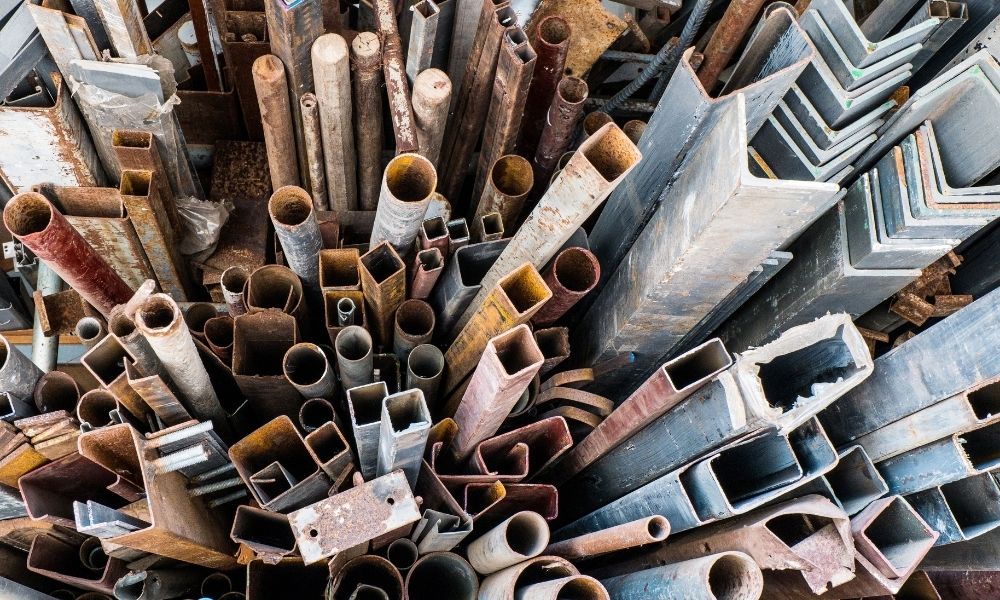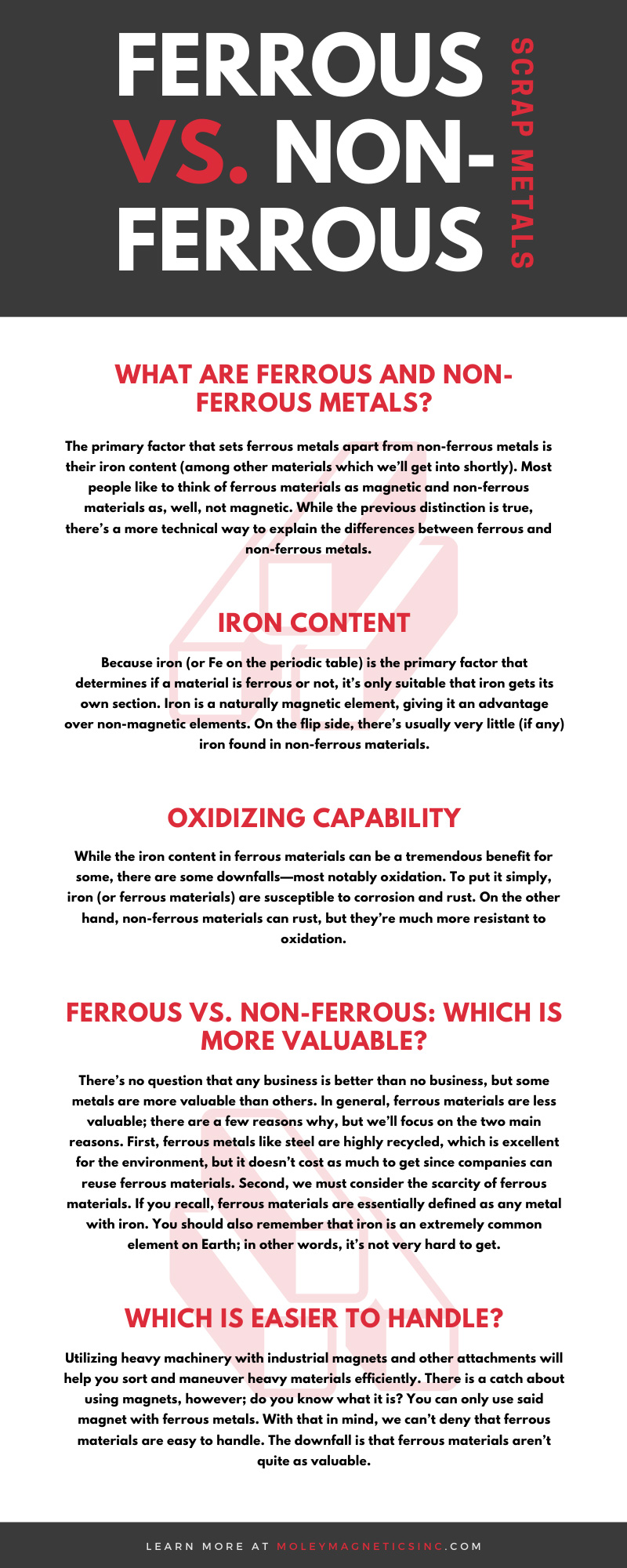
Ferrous vs. Non-Ferrous Scrap Metals
The scrap metal has seen exponential growth over the course of centuries; in fact, it’s a $29.9 billion industry as of 2020. In addition to the growing industry, there are millions of people the industry employs year over year. Included in those millions of people are CEOs, upper-management, supervisors, and every other employee. Regardless of which employee you are, you must have a solid understanding of the different materials you handle. In the scrap metal industry specifically, you’ll handle a lot of ferrous and non-ferrous materials. Whether you’re a line worker in a scrap metal facility or you own the company, you must understand ferrous vs. non-ferrous scrap metals. If you’d like to learn more about ferrous and non-ferrous metals and how they can affect your scrap metal business, we’ve got you covered; read on to learn more.
What Are Ferrous and Non-Ferrous Metals?
The primary factor that sets ferrous metals apart from non-ferrous metals is their iron content (among other materials which we’ll get into shortly). Most people like to think of ferrous materials as magnetic and non-ferrous materials as, well, not magnetic. While the previous distinction is true, there’s a more technical way to explain the differences between ferrous and non-ferrous metals.
Iron Content
Because iron (or Fe on the periodic table) is the primary factor that determines if a material is ferrous or not, it’s only suitable that iron gets its own section. Iron is a very common element found on Earth; it actually makes up a large portion of the earth’s core. Iron is a naturally magnetic element, giving it an advantage over non-magnetic elements. On the flip side, there’s usually very little (if any) iron found in non-ferrous materials.
The primary benefit of iron is its magnetism. When a magnetic field passes over metals with iron in them, the iron’s electrons are attracted to one side of the atom. Unsurprisingly, the iron content in some metals makes sorting them at a scrap yard effortless with the aid of a magnet. Although there are several types of ferrous metals, the most common include steel, carbon steel, alloy steel, cast iron, and wrought iron. Alternatively, the most popular non-ferrous metals are aluminum, copper, tin, gold, and silver.
Oxidizing Capability
While the iron content in ferrous materials can be a tremendous benefit for some, there are some downfalls—most notably oxidation. To put it simply, iron (or ferrous materials) are susceptible to corrosion and rust. On the other hand, non-ferrous materials can rust, but they’re much more resistant to oxidation. Rust can appear on ferrous materials for a number of reasons, but it’s typically from coming into contact with water.
How Ferrous and Non-Ferrous Materials Affect Your Business
By now you’re probably wondering how all this information applies to your scrap metal business. Good question. We’re first going to look into which material consumers and companies value more. We’ll also consider which metal is easier to handle in your scrap yard.
Ferrous vs. Non-Ferrous: Which Is More Valuable?
There’s no question that any business is better than no business, but some metals are more valuable than others. In general, ferrous materials are less valuable; there are a few reasons why, but we’ll focus on the two main reasons. First, ferrous metals like steel are highly recycled, which is excellent for the environment, but it doesn’t cost as much to get since companies can reuse ferrous materials. Second, we must consider the scarcity of ferrous materials. If you recall, ferrous materials are essentially defined as any metal with iron. You should also remember that iron is an extremely common element on Earth; in other words, it’s not very hard to get. Between the common practice of recycling ferrous metals and the amount of iron available, it shouldn’t be surprising that ferrous materials aren’t treasured as much.
On the other hand, non-ferrous metals include anything that doesn’t contain iron. While “anything without iron” sounds simple enough, it also includes precious metals such as gold and silver. As you probably suspect, the precious metals are worth more than both ferrous and other non-ferrous metals, but that doesn’t mean the other non-ferrous metals aren’t valuable. The price of aluminum typically remains relatively level because most people are good at recycling aluminum. On the other hand, metals like copper, brass, and zinc are more difficult to manufacture and find. All that said, the prices of non-ferrous metals are generally higher because of their scarcity, time, and resource-consuming manufacturing process.
Which Is Easier To Handle?
Regardless of the size of your scrap yard and the age of your business, you probably use heavy machinery to make your operations more efficient. Of course, large-scale scrap yards might have cranes equipped with a crane magnet; that said, most scrap yards will have at least one excavator equipped with an excavator magnet .Utilizing heavy machinery with industrial magnets and other attachments will help you sort and maneuver heavy materials efficiently. There is a catch about using magnets, however; do you know what it is? You can only use said magnet with ferrous metals. With that in mind, we can’t deny that ferrous materials are easy to handle. The downfall is that ferrous materials aren’t quite as valuable.
A common conundrum scrap yards face is deciding whether they should focus on the sheer volume of ferrous materials that are easier to handle even though they aren’t as valuable. On the other hand, they could focus their business on non-ferrous materials that are more valuable but also more scarce. While we won’t tell you how to operate your business, we can provide some insight. Most scrap yards find it valuable to handle a little of everything or break their focus up into percentages. Of course, you’ll need to run the numbers for yourself with your customer base in mind. Some scrap yards find it scalable to focus 70% of their business on ferrous materials and the other 30% on the more valuable non-ferrous metals. Alternatively, other scrap yards will do an even 50-50 split, or they may focus largely on non-ferrous metals—it’s all dependent on your customers and the materials you’re sourcing.
In addition to understanding the differences between ferrous and non-ferrous scrap metals, you’ll also need a dependable equipment supplier on your side. Moley Magnetics specializes in offering top-quality industrial magnets and other attachments, but we don’t stop there. Our team is made up of experienced industry professionals who provide a variety of repair services. If you need a new magnet to support your scrap yard business or a repair, give us a call. We look forward to working with you.


